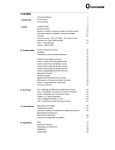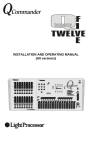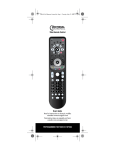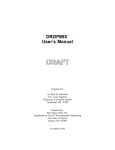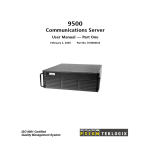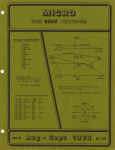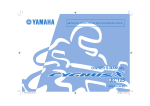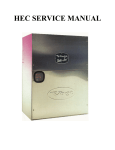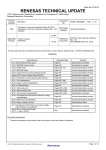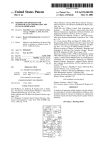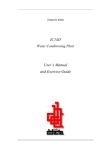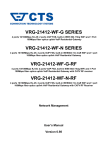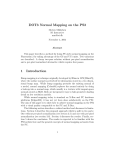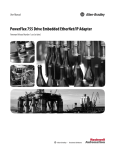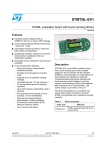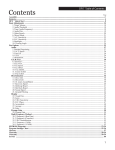Download User Manual - High End Systems
Transcript
User Manual 2217 West Braker Lane Austin, TX 78758 USA (512) 836-2242 www.highend.com Power Cue DMX TM © 1999 High End Systems, Inc. Power Line 2217 West Braker Lane Austin, TX 78758 USA www.highend.com (512) 836-2242 QCOMM/ENG/2.00A/02/99 CONTENTS I. Introduction II. SetUp General Principles Front Panel Layout and Function Rear Panel Layout and Function Passcodes Channel Names Keys - Latch, Flash, Swap, Solo Fixtures - Selecting Types, Setting DMX Address Groups Channel Types - HTP, LTP, Permanent - Dim, Switch, Snap Patch - The Input Extender Comms. - RS232, MIDI 1 2 4 6 8 10 12 14 16 20 22 III. Programming Scenes, Moving Lights SavePalet Transparency and Overlay Explained Preset Focus Auto Check Error Detection 16-bit fades, Mirror Locks Scenes, Generic Lighting. Selecting Channels Scenes, Generic Lighting. Selecting Groups Scenes, Generic Lighting. Scene Attributes Scenes, Copying and Clearing Memories Chases Output Keys Deleting the Contents of a Key Shows - Real Time Programming Notes on Shows, Deleting a Show 24 30 31 32 34 35 36 38 40 42 44 46 49 50 52 IV. Run Mode Find - Locating Effects on Output Keys View - Viewing the Contents of an Output Key Levels - Monitoring Channel Activity Capture - Grabbing a Look Adjust - Altering the Speed of a Chase Live - Live Control of Moving Light Channels 54 56 58 60 62 64 V. Card Menu Specification, Formatting Copying Data to and from the Card System Sub-menu - Updating the Operating System, Updating the Fixture Library Erasing Memories Configuration Options 66 66 68 68 69 70 VI. Appendices MIDI Connections - Pin-outs Getting Help Conformity 72 74 76 77 © High End Systems, Inc. 1999, All Rights Reserved Information and specifications in this document are subject to change without notice. High End Systems, Inc. assumes no responsibility or liability for any errors or inaccuracies that may appear in this manual. The system software for Power Cue DMX described in this manual is furnished under license, and is protected by copyright law and international treaties. Trademarks used in this text: High End Systems is a registered trademark; and Power Line, Power Cue DMX, and Fader Panel are trademarks of High End Systems, Inc. Other trademarks and trade names may be used in this document to refer to either the entities claiming the marks and names or their products. High End Systems disclaims any proprietary interest in trademarks and trade names owned by others. Contacting High End Systems U.S. and the Americas: Sales Department: High End Systems, Inc. 2217 West Braker Lane Austin, TX 78758 USA voice: (512) 836-2242 FAX: (512) 837-5290 Customer Service:High End Systems, Inc. 2227 West Braker Lane Austin, TX 78758 USA voice: (800) 890-8989 24-hour FAX: (512) 834-9195 24-hour voice mail: (512) 837-3063 or (800) 890-8989 U.S. West Coast: High End Systems, Inc. 8200 Haskell Avenue Van Nuys, CA 91406 USA voice: (818) 947-0550 FAX: (818) 908-8975 World Wide Web: http://www.highend.com Product Modification Warning High End Systems products are designed and manufactured to meet the requirements of United States and International safety regulations. Modifications to the product could affect safety and render the product non-compliant to relevant safety standards. Mise En Garde Contre La Modification Du Produit Les produits High End Systems sont conçus et fabriqués conformément aux exigences des règlements internationaux de sécurité. Toute modification du produit peut entraîner sa non conformité aux normes de sécurité en vigueur. Produktmodifikationswarnung Design und Herstellung von High End Systems entsprechen den Anforderungen der U.S. Amerikanischen und internationalen Sicherheitsvorschriften. Abänderungen dieses Produktes können dessen Sicherheit beeinträchtigen und unter Umständen gegen die diesbezüglichen Sicherheitsnormen verstoßen. Avvertenza Sulla Modifica Del Prodotto I prodotti di High End Systems sono stati progettati e fabbricati per soddisfare i requisiti delle normative di sicurezza statunitensi ed internazionali. Qualsiasi modifica al prodotto potrebbe pregiudicare la sicurezza e rendere il prodotto non conforme agli standard di sicurezza pertinenti. Advertencia De Modificación Del Producto Los productos de High End Systems están diseñados y fabricados para cumplir los requisitos de las reglamentaciones de seguridad de los Estados Unidos e internacionales. Las modificaciones al producto podrían afectar la seguridad y dejar al producto fuera de conformidad con las normas de seguridad relevantes. Warranty Information Limited Warranty Unless otherwise stated, your product is covered by a one year parts and labor limited warranty. Dichroic filters and LithoPatterns® high resolution glass gobos are not guaranteed against breakage or scratches to coating. It is the owner’s responsibility to furnish receipts or invoices for verification of purchase, date, and dealer or distributor. If purchase date cannot be provided, date of manufacture will be used to determine warranty period. Returning an Item Under Warranty for Repair It is necessary to obtain a Return Material Authorization (RMA) number from your dealer or point of purchase BEFORE any units are returned for repair. The manufacturer will make the final determination as to whether or not the unit is covered by warranty. Lamps are covered by the lamp manufacturer’s warranty. Any Product unit or parts returned to High End Systems must be packaged in a suitable manner to ensure the protection of such Product unit or parts, and such package shall be clearly and prominently marked to indicate that the package contains returned Product units or parts and with an RMA number. Accompany all returned Product units or parts with a written explanation of the alleged problem or malfunction. Ship returned Product units or parts to: 2227 West Braker Lane, Austin, TX 78758 USA. Note: Freight Damage Claims are invalid for fixtures shipped in non-factory boxes and packing materials. Freight All shipping will be paid by the purchaser. Items under warranty shall have return shipping paid by the manufacturer only in the Continental United States. Under no circumstances will freight collect shipments be accepted. Prepaid shipping does not include rush expediting such as air freight. Air freight can be sent customer collect in the Continental United States. REPAIR OR REPLACEMENT AS PROVIDED FOR UNDER THIS WARRANTY IS THE EXCLUSIVE REMEDY OF THE CONSUMER. HIGH END SYSTEMS, INC. MAKES NO WARRANTIES, EXPRESS OR IMPLIED, WITH RESPECT TO ANY PRODUCT, AND HIGH END SPECIFICALLY DISCLAIMS ANY WARRANTY OF MERCHANTABILITY OR FITNESS FOR A PARTICULAR PURPOSE. HIGH END SHALL NOT BE LIABLE FOR ANY INDIRECT, INCIDENTAL OR CONSEQUENTIAL DAMAGE, INCLUDING LOST PROFITS, SUSTAINED OR INCURRED IN CONNECTION WITH ANY PRODUCT OR CAUSED BY PRODUCT DEFECTS OR THE PARTIAL OR TOTAL FAILURE OF ANY PRODUCT REGARDLESS OF THE FORM OF ACTION, WHETHER IN CONTRACT, TORT (INCLUDING NEGLIGENCE), STRICT LIABILITY OR OTHERWISE, AND WHETHER OR NOT SUCH DAMAGE WAS FORESEEN OR UNFORESEEN. Warranty is void if the product is misused, damaged, modified in any way, or for unauthorized repairs or parts. This war GENERAL PRINCIPLES The Power Cue DMX is designed to control most types of intelligent and generic lighting that will be encountered in entertainment venues today. It has the following capacities: •256 DMX output channels •512 scenes •64 chases of 64 steps •16 groups •16 intelligent fixtures •29 channels (max.) per fixture •8 Looks (snapshot memories) •8 shows of 500 events •64 playback keys •16 channel analog input SetUp Before making programs it will be necessary to configure the Power Cue DMX in respect of the lighting being used and of user preferences. This procedure is discussed in Section ll, Setup. Menu Structure The programming interface is a backlit LCD display, showing multi-level menus. All valid options within a menu are displayed and appear as labels to eight push buttons (softkeys) above and below the display. Where necessary, a menu choice is confirmed by pressing the STORE/YES button to the right of the display; a menu choice is cancelled by pressing the ESCAPE/NO button to the left of the display. Intelligent Lights For the purposes of the Power Cue DMX an intelligent light (fixture) may be defined as any lighting projector which has multiple channels and for which the Power Cue DMX contains a personality. The Power Cue DMX can control up to 16 such fixtures with separate DMX addresses and with differing personalities. If required, several identical fixtures may be assigned to one DMX start address and may be considered as one out of the sixteen. Fixture Personalities When working with fixtures, it is necessary to software install them through the setup menu, so that the Power Cue DMX knows the personalities of the fixtures concerned, their position in the DMX chain and which button calls which fixture. A library of fixture personalities exists within the Power Cue DMX. This library is updated periodically and users may obtain updates from their dealer. See our website for the latest fixture library information. Scenes and Chases The programming structure works in this way. Fixtures are programmed into positional settings called scenes; a number of scenes is then programmed into a sequence called a chase. The chase, alone or in combination with other chases and effects is subsequently assigned to an output key from which it may be called up or run. Generic Lights Scenes may also be constructed for use with generic lighting. They may then be recalled from output keys as static scenes or they may first be chained together into a scene chase. Alternatively a scene may be designated a zone where the lamps run a pattern through the selected channels. Sound-to-light scenes may also be programmed. Looks A snapshot of the current outputs may be captured as a look. The look is then assigned to any available output key. This feature must first be enabled via the system options utility. Shows A timed sequence of key presses, comprising scenes, zones, chases, individual channels and 1 looks. It may be programmed in real time by storing actual events as they happen. You may subsequently edit the list of events and their desired run times. Memory Card The Power Cue DMX has a PCMCIA memory card slot which allows you to save all your programming to a suitable memory card. Conversely you may upload from a memory card into the Power Cue DMX. New versions of the operating system may be loaded via a memory card and new intelligent fixture personalities may also be uploaded via the card slot. FRONT PANEL LAYOUT AND FUNCTIONS Display and softkeys, STORE/YES and ESCAPE/NO buttons This is the heart of the programming interface. The eight buttons, top and bottom of the display, change their function according to the task being executed at the time. The display indicates the current function of each button. The STORE/YES button is used to confirm a selection or action. The ESCAPE/NO button is generally used to abort or cancel an operation . Alphanumeric pad Any item that you can program can be given a name. This keypad is used to write names in the display. When you create effects with intelligent fixtures, the buttons in this keypad represent the various functions of the fixture. In some instances numeric values may be entered using this keypad, although the trackball is more often used. Push buttons There are sixteen illuminated push buttons. During programming they represent the sixteen intelligent fixtures that 2 may be driven by the Power Cue DMX. They may also be programmed to contain pre-defined groups of channels and subsequently during scene programming to call these groups into a scene. They may also be used as output keys. In RUN mode (playback) they are used to recall those effects programmed into them. In this context they may be set to latch, flash, swap or solo. Touchkeys There are sixteen illuminated touchkeys. These may be set to latch, flash, swap or solo. They may be used during playback as output keys to recall those effects programmed into them. Page keys There are two pages of push buttons and two pages of touchkeys, so the physical number of keys is effectively doubled in both cases, making a total of 64 virtual output keys. Trackball The trackball is used during programming for all functions that require the setting of a level. When applied to mirror movement, it operates in both vertical and horizontal planes; for all other effects it operates only in the vertical plane. When using the live facility in RUN mode, the selected fixture attribute is adjustable live from the trackball. Master slider The master slider controls the overall output of all channels on the desk, for which the type has been set as dimmer, regardless of their highest takes precedence/lowest takes precedence (HTP/LTP) status. (HTP and LTP are discussed further in the “Setup Channel Type” section.) Channels not specifically set as dimmer will not be affected. Any channel output level is multiplied by the current level of the master to give its output level. When in RUN mode the level of the Master is shown by a band of asterisks running horizontally across the display. The master slider can be enabled/disabled independently for each channel. Blackout switch Operation of the blackout switch takes all dimmer and shutter channel levels instantly to zero, regardless of their HTP/LTP status. If used in conjunction with button 0 on the alphanumeric keypad, then ALL channel levels will be set to 0 and all key commands are cancelled. When in RUN mode a blackout is indicated by the word 'Blackout' above the asterisks indicating the level of the Master. The blackout switch can be enabled/disabled independently for each channel. Light socket This socket provides a drive voltage for an operating light. We recommend a 12 inch Littlite, G Series with a type 1815 lamp. 3 REAR PANEL LAYOUT AND FUNCTIONS Power supply (PSU) input The pin connections are shown on the rear of the unit and later in this manual in the section, “Connections”. Use only a genuine Power Line power supply unit (PSU). PC Card slot The memory card is a PC Card Type 1, 512Kb SRAM. Card operations are dealt with in section V. You can use memory cards to: (a) Update the operating system (b) Upload new intelligent fixture personalities (c) Save and upload programming DMX output The DMX output connector is a 5-pin female XLR, wired to the standard USITT DMX1990 configuration. Auxiliary Control Input The pin connections are shown on the rear of the unit and in the section, “Connections”. This connector allows the connection of external analog devices such as the Power Cue DMX Fader Panel. Audio Input Chases and zones may be run to one of the audio regimes, either via the internal microphone or via audio input through the jack socket. Inserting a jack plug disables the internal microphone. Alternatively scenes may to set to respond to sound input by selecting the type sound-to-light. LCD Display Contrast Adjuster A rotary display contrast adjustment is provided to compensate for varying viewing angles and lighting levels. MIDI The MIDI strategy is for key actions to respond to note on and note off messages. The Power Cue DMX can be set to send note on and note off messages corresponding to key presses. RS232 Not implemented. 4 5 Before you can use the Power Cue DMX there are several features that should be configured via the set up menu. When you switch on the Power Cue DMX, the first screen you see will show several options, one of which is SetUp. At other times SetUp may be accessed by pressing Escape when the display shows RUN MODE. SET UP PASSCODES You may set passcodes to protect the Prog/Edit menu, the Setup menu and the Card menu. The code to the setup menu is the master and has global access. When your Power Cue DMX is delivered, it is set up with the passcode 0000 and all menu levels are open. Setting up the passcode with anything other than 0000 invokes the security system. Any security system in place may be cancelled by re-instating the passcode 0000. 1. Press SetUp 2. You must know the current passcode protecting a menu, in order to access the menu. (The default is 0000.) 6 5. Select one of the three menus to protect. 6. Enter the CURRENT passcode for the You may choose a different password for each menu. selected menu, using the numeric keypad, like you did in step 3. TIP! Since there are three menus to protect, there can be three different passcodes. Make them unforgettable or write them down and keep them handy. . Neither uploading a new operating system nor erasing everything in the system options menu erases current passcodes. !!! All the instruction sequences in this manual start from the MAIN MENU screen. If you are in RUN mode, press ESCAPE to get to MAIN MENU. 4. Now you can proceed to the SetUp menu and select the passcode option. 3. Use the numeric keypad to enter the current 4-digit code. Press YES. •Press Setup •Enter current code •Press Pswd •Select menu to protect •Enter current code •Enter new code 7. Enter the NEW passcode, using the numeric keypad, like you did in step 3 and press STORE. You have now looped to step 5. Protect another menu or press ESCAPE to go back a level. 7 SET UP CHANNEL NAMES This section discusses how to name channels, which can make them easier to remember. 1. Press SetUp. Enter the SetUp passcode, if 2. Press ChnName active. 4. Enter or edit the channel name as shown in step 5. NOTE: Channels used by fixtures are named automatically during the setup fixtures routine. The automaticallyassigned names may not be overwritten. If you are using fixtures, install them first. 8 5.Use the alpha-numeric pad to enter a new name or edit the existing one. Press STORE when finished.You have now looped back to step no. 3 and can scroll to another channel or press ESCAPE to go backwards through the menu levels. 3. Scroll through the channels list, using the UP and DOWN buttons. Press STORE to select a channel. •Press SetUp •Press ChnName •Scroll to a channel and press STORE •Type a name •Press STORE 9 SET UP KEYS Both the push buttons and the touchkeys may be configured according to the following options. Both the buttons and the keys are grouped left and right over two pages. A selected attribute applies to all keys in the group. 1. Press SetUp. Enter the passcode, if prompted. Note these abbreviations for the various button groups:PBL1 = Push buttons, page 1, left PBL2 = Push buttons, page 2, left PBR1 = Push buttons, page 1, right PBR2 = Push buttons, page 2, right TKL1 = Touchkeys, page 1, left TKL2 = Touchkeys, page 2, left TKR1 = Touchkeys, page 1, right TKR2 = Touchkeys, page 2, right 10 2. Press Keys. 3. Select a group of keys to setup. Scroll through the options to make your selection. Repeat this procedure for other groups. Press STORE and return to step 2. •Press SetUp •Press Keys •Select a group of keys •Bump to the desired option •Press STORE when finished These are the available functional modes. Except where the function is Global, it applies only within the group:Latch and Add - A pressed key remains switched on until pressed a second time. All keys may be switched on at any one time. Flash and Add - A pressed key remains switched on only while it is pressed. All keys may be switched on at any one time. Latch and Swap - A pressed key remains switched on until pressed a second time. Only one key may be switched on at any one time; pressing a second key switches off the first one. Flash and Swap - A pressed key remains switched on only while it is pressed. Only one key may be switched on at any one time; pressing a second key switches off the first one. Latch and Solo, Global - A pressed key remains switched on until pressed a second time. A solo key has no effect on keys already switched on. When a solo key is switched on, all keys are disabled until the solo key is switched off. Flash and Solo, Global - A pressed key remains switched on only while it is pressed. A solo key has no effect on keys already switched on. When a solo key is switched, all keys are disabled until the solo key is switched off. 11 SET UP FIXTURES The Power Cue DMX contains a library of a great number of intelligent fixture personalities. Before you can use a fixture, it must first be assigned a personality and a DMX start address. 1. Press SetUp. Enter the passcode, if prompted. 12 2. Press Fixts. The Power Cue DMX can control up to 16 fixtures. They will appear in the display as nos. 01-16 and initially have no personality, i.e. they are UNASSIGNED. You will next select a personality for each fixture you wish to control. 4. Scroll to the fixture type you want to use. 5. The Power Cue DMX automatically sug- Press STORE. gests a DMX start address. Press STORE to accept the suggestion or use the trackball or numeric keypad to select a different one. Press STORE. You are now back at step no. 3. Repeat steps 3 to 5 to assign the next fixture or press ESCAPE to go backwards through the menu levels. If you choose an address that conflicts with a previous selection, i.e. you have overlapping channel addresses, then the word overlap appears in the display in step 5 alongside the caption DMX ADDRESS to indicate that the address is invalid. Pressing STORE causes the message 'ASSIGNMENT ERROR' to be displayed in step 3. above alongside the fixture number. 3. Scroll to the fixture number you want to set up and press ASSIGN. If you attempt to assign a fixture that is already assigned, you may adjust the PAN, TILT and AXIS but not the DMX address. To change the DMX address, you must first remove the fixture and then re-assign it with the new address. When setting up your fixtures you will need to make certain DIP switch selections on the fixture itself. Often there are two DIP switches, one for the personality and one for the DMX start address setting. The main personality setting will often involve a choice between some other type of protocol and DMX. Always choose DMX when working with the Power Cue DMX. Other available settings will vary according to the model and brand of fixture. •Press SetUp •Press Fixts •Select from 1-16 and press ASSIGN •Select fixture type and press STORE •Set DMX address and press STORE It is easy to become confused when working with fixtures that are not all the same way up or facing in the same direction. The Power Cue TIP! DMX helps you here. The PAN and TILT options in step 5. above allow you to change left to right and right to left, so that you can work on opposite sides of a room simultaneously. AXIS allows you to switch horizontal and vertical and is useful when working with fixtures installed horizontally instead of vertically. You will need to set a DMX start address for each fixture on the other DIP switches. These addresses must correspond to the addresses you set on the Power Cue DMX. Please refer to the manual for your fixtures for instructions. Many intelligent fixture instruction manuals also provide a table, showing how to set the DIP switches for any required address. 13 SET UP GROUPS Where you need to use certain channels together on a regular basis, you will find it easier and quicker to call them into a scene as one group, rather than many individual channels. This routine shows you how to define the channels in a group. You may define a total of 16 groups. 1. Press SetUp. Enter the SetUp passcode, if 2. Press Group. prompted. 4. Press one of the sixteen illuminated push 5. Scroll through the channels and buttons. This is where the groups will reside. assign/remove channels, using the appropriate button. Selected (assigned) channels show *. During programming selected channels are output at full brightness. Press STORE when you have finished selecting channels for this group. When you call a group into a scene, all channels will be set at full brightness. Having called the group you can then change the level of individual channels by selecting channels in the scene programming menu. 14 TIP! 3. Select the group to setup. NOTE: Setting up one of the 16 groups for a second time will result in the original setup being overwritten. •Press SetUp •Press Groups •Press button for Group •Select channels to include •Press STORE when finished 15 SET UP CHANNEL TYPES Just as each channel may be named, it may also be given certain characteristics to determine how it will respond to a control signal: •what function is assigned to it. •whether the channel may be faded, switched or snapped. •whether it works HTP, LTP or is permanently on. •whether it responds to the DBO switch, the Master fader, both or neither. When the Power Cue DMX is first switched on, all channels are set by default to type = dimmer/DBO, mode = fade and output = HTP. The Attributes All channels are of the type DIMMER by default. DIMMER channels are subject to the MASTER FADER and to the blackout switch. When you set up intelligent lights (fixtures), this type will be changed automatically to MIRROR X, COLOR, GOBO, etc., as appropriate. These channels are not subject to the master but the dimmer channel of an intelligent light will remain typed as a DIMMER. •TRUE/INVERT You will usually require a channel to be fully off at DMX value 0 and fully on at 255. By selecting ‘Invert’ you can reverse the channel’s functionality, so that DMX value 0 is fully on and 255 is off. Note that some intelligent lights have their shutter fully closed at 255. The Power Cue DMX sets shutters to 0 at the end of a chase: in such a case you would set the channel type True/Invert to Invert. •DBO/No DBO An HTP dimmer channel which is DBO is subject to the master slider and the DBO switch. An HTP dimmer channel which is NoDBO will respond to the Master slider only. An HTP non-dimmer channel which is DBO will respond to the DBO switch only. An HTP non-dimmer channel which is NoDBO will respond to neither the Master slider nor the DBO switch. An LTP dimmer channel which is DBO is subject to the DBO switch only. An LTP dimmer channel which is NoDBO will respond to neither the Master slider nor the DBO switch. An LTP non-dimmer channel which is DBO will respond to the DBO switch only. An LTP non-dimmer channel which is NoDBO will respond to neither the Master slider nor the DBO switch. To understand why the above is important, consider this situation. The Power Cue DMX has the facilities to program 16 moving lights by refering to their pre-installed personalities and picking up each attribute in turn from the alphanumeric keypad. You can install additional moving lights and program them channel by channel, as you would have to do on a less-advanced desk. Let us imagine that a fixture you are installing by this method has no dimmer channel and that dimming is effected by means of the shutter channel. The correct output type for most moving light channels is LTP (and the mode should be fade or snap) but if the shutter channel is left as LTP, the shutters will not come down at the end of a chase. To cure this problem the shutter channel therefore needs to be set to HTP. It also needs to be set to dimmer/DBO, in order that the shutter responds to the DBO switch and the Master slider. •MODE The channel mode is either FADEing, SWITCHing or SNAPping. FADE channels may move from any one level to another at any speed that you set. An example of FADE channels would be intelligent fixture mirror channels. SNAP channels may move from any one level to another but at the maximum speed allowed by the fixture. Intelligent fixture color/gobo wheels are normally SNAP channels. SWITCH channels are either on or off. Channels connected to a switching power pack would be set to SWITCH mode. 16 •OUTPUT Outputs are either LTP, HTP or PERM. A channel can only output one level at any one time. If it receives more than one output command, which one should it choose to obey? LTP, HTP and PERM lays down the rules for this situation, following conventions established for various types of device. LTP channels respond to the latest command received. Most intelligent light channels are customarily set to LTP, allowing, for example, overlayed color/gobo information, hence last takes precedence, or LTP. HTP channels respond to the highest level instruction received. Such a setting is appropriate for intelligent fixture dimmer channels as mentioned above and also for dimming power packs. If two scenes are output to the same channels, it will be the highest level signal in each channel that will be obeyed. PERM channels remain on, even when a general blackout is in force. This is to cater for those lamp types which need to cool when switched off before they can be switched on again. The PERM output is also suitable for color changer lamps, while the changing mechanism would be set to LTP. 17 SET UP CHANNEL TYPE 1. Press SetUp. Enter the setup menu passcode, if prompted. 18 2. Press ChnTyp. •Press SetUp •Press ChnTyp •Set the attributes •Press STORE 3. Scroll to the desired channel and adjust the attributes. Then press ESCAPE. See the notes opposite for an explanation of the attributes. 19 SET UP PATCH - THE FADER PANEL The Power Cue DMX allows you to patch various types of effect to an external control device, usually with faders, so that such effects may be faded in and out or set at varying levels and not just switched on and off. The Power Cue DMX lets you make 16 of these patches. Power Line produces the Power Cue DMX Fader Panel specifically for this purpose. Your Power Cue DMX may have been delivered complete with a Fader Panel already fitted. If not, it is still possible to add one as a separate unit, connected via a data cable supplied with the Fader Panel. Contact your dealer for details. In both cases power comes from the Power Cue DMX and no further external power source is required to drive the Fader Panel. Alternatively, you may use any lighting desk giving a 0-10V analog output. Make a suitable cable to connect 16 desk channels to the Power Cue DMX’s auxiliary control input (pin connections detailed below). Note that the desk must be powered in the usual way and not from the Power Cue DMX. Therefore, when you make your cable, do not connect pins 14 and 15 at the Power Cue DMX end. Using programs you have already made you may assign to a fader : •a scene, •a chase, •a channel, •the contents of an output key. You may elect to patch all channels of a chosen scene to the fader or just the HTP channels; this allows the dimming up/down of moving lights without affecting LTP channels, such as mirrors and color wheels. When patching chases, only HTP channels respond to the fader, in order that the fader does not interfere with mirror movement, color wheels etc. The patch is programmed via the Power Cue DMX’s SetUp menu as detailed below. Using a fader while you are In RUN MODE will cause the patched effect to be sent to the outputs. When a scene is patched to a slider, a copy of the scene is made and and assigned to a memory of its own. When you edit the original scene, the patched scene will not be updated. You must make the patch again to update it. 20 TIP! 1. Press SetUP 2. Press Patch. • Press SetUp • Press Patch • Choose Type, Item and Method • Press STORE 3. Scroll to one of the 16 available patches. Select the effect TYPE you want to use (scene, chase, et.c.) and then use the trackball to scroll through the scene list (chase list et.c.). to select the item to patch. Use the METHOD button to select a patch of all channels within the effect or just the HTP channels. Press STORE when finished. NOTE: To patch a moving zone, you choose the type ‘scene’; see Programming Scenes - Generic Lighting. 21 SET UP COMMS. The Power Cue DMX may be set up to communicate using MIDI or RS232, depending on the functionality required. Jumpers on the Power Cue DMX's main circuit board may need to be set to change from the factory setting of MIDI to RS232. This procedure is illustrated in the boxes on the right. See the options section and MIDI Appendix for further information. RS232 functions not yet implemented. 1. Press SetUp. 22 2. Press Comms. Position jumpers as shown to set the Comms. mode for either MIDI or RS232. •Press SetUp •Press Comms •Press STORE •Press ESCAPE 3. Press STORE to initialise the Comms mode. 4. Check display to verify that the desired Comm mode has been initialised. Press ESCAPE to return to main menu. 23 PROGRAMMING SCENES - AN OVERVIEW All output is made from the push buttons and the touchkeys. The object of programming is to create effects and then to load those effects on to the push buttons and the touchkeys for output. The basic building unit is the channel. Channels may be loaded directly on to output keys or they may be combined into scenes. All 256 channels are freely programmable and none are dedicated to any specific function. Scenes may be constructed in two ways: (A) With fixtures, which may otherwise be called moving lights, intelligent lights or scanners. To build this type of scene, the programmer selects one or more of the sixteen fixtures available and set up as previously described. Calling up a fixture makes the corresponding channels available by selection of an attribute on the alpha-numeric keypad and then adjustment of the level using the trackball. After adjustment of the various fixture channels the scene is stored. A number of such scenes may be built into a sequence which we call a chase. Chase programming is dealt with in the “Programming a Chase” section later in this manual. (B) Scenes using other types of device require programming in two stages. First, the channels to be included in the scene need to be defined. They can be called up individually or by calling up a (A) PROGRAMMING A SCENE WITH MOVING LIGHTS 1. Press Prog/Edit 24 2. Press Scene You have 512 scene memories at your disposal. Keep your different scene types in separate areas and so avoid confusion. When programming/editing scenes a long way down the list instead of repeatedly pressing PageDN, you can use the numeric keypad and enter the number of the scene you wish to use. TIP! previously-defined group. The scene is then further defined by giving it certain attributes to determine its appearance: •It may appear as a static scene. In this case you have the option to set fade in and fade out times. Besides driving generic lighting a static scene could be used to energise strobes or smoke machines or to operate motors. •It may appear as a sound-to-light-scene and each channel may be set to respond to bass, tenor, alto or treble input. •It may appear as a zone (chasing channels). With a zone you can adjust: the run speed select step to audio or the internal clock switch or crossfade continuous loop or one-shot set an overall dim level choose a pattern •Press Prog/Edit •Press Scene •Select a memory •Press Fixture •Continue over page 3. Scroll to the desired scene and press STORE. If you are editing a previouslyprogrammed scene, you may enter the scene number on the alphanumeric keypad, instead of scrolling through the scene list. Enter all three digits, e.g. 009, not just 9. 4. Press Fixture A previously-programmed scene will have a name. You may edit such scenes or clear them altogether (see page 34). An overlay scene is labelled ‘ov’. Scenes 450 to 495 (presets) can be flagged ‘p’ or ‘P’. See pages 32 and 33 for more information. 25 PROGRAMMING A SCENE WITH MOVING LIGHTS - CONTINUED 5. Select the fixtures to include in the scene, using the illuminated push buttons. During setup you allocated personalities and DMX addresses to fixtures 1-16. Fixtures 1-16 were automatically assigned to the 16 illuminated push buttons above the touchkeys. These buttons are now flashing. Push one or more buttons to select fixtures. If more than one fixture is selected, they must be of the same type. 6. Use the attributes keypad and the trackball to adjust each attribute of the selected fixtures. Press STORE when all channels have been adjusted as required. If you try to adjust an attribute that does not exist on this type of fixture, the instruction is ignored and the message no valid channel type is displayed. Note that the buttons can have multiple functions with the exception of the mirror button. For example, pushing the top left button will give access to the first (or only) color wheel; pushing it again accesses the second color wheel but only if this type of fixture has a second color wheel. See notes at the end of this section for more information about 16-bit mirror fades, mirror locks, overlay scenes and preset focus 26 TIP! The display shows the type of fixture being used, the attribute currently being adjusted and the level of the channel (or two channels in the case of XYmirror movement), expressed as a number between 0 and 255 (or 0 and 65535 in the case of 16-bit mirror channels). You may now want to retain the adjustments made so far and make changes to other fixtures. 7. Press STORE to save the scene or ESCAPE to abort the programming. •Select fixtures •Adjust attributes •Press STORE to save •Continue over page De-select the first fixture(s) by pressing the appropriate push buttons and select others in the same way. The selected ones flash more brightly than the rest. Repeat step 6. for this second set of fixtures. When the various attributes have been adjusted, press STORE. 27 PROGRAMMING A SCENE WITH MOVING LIGHTS - CONTINUED 8. Give the scene a name. Use the alphanumeric keypad to name or re-name a scene, using the yellow legend. One press of the button marked ABC will display an A above the cursor ^. A second press will display a B, a third press will display a C and a fourth press a 1. Move the cursor one space right by pressing NextChar and one space left by pressing PrevChar or if you pause between presses, the cursor automatically advances to the next character. 28 9. The scene was saved in step 7. Press ESCAPE now to go back to step 3. and exit to the main menu. Press STORE to go to step 4. and start programming a scene in the next scene memory. •Name the scene •Press ESC to exit, STORE to program another scene Where there are several sequential scenes with the same name, the Power Cue DMX will give them a number in addition to the name. For example, if two scenes are programmed with the name open white, the first one is referred to as open white and the second one as open white [001]. 29 SAVEPALET EXPLAINED SavePalet is used with moving light scene programming to enable you to repeat settings of the various attributes during later programming. You may save 16 settings of each fixture attribute. Remember that it works with any individual attribute, not whole scenes; whole scenes may be repeated using COPY. Here is an example of how you might use SavePalet to facilitate your color programming. Read the instructions below in conjunction with the scene programming procedure beginning on page 24. SAVING RECALLING 1(a). 2(a). 1(b). 2(b). 1(c). 2(c). 1(d). 2(d). 1(e). 1(a). All 16 fixtures are selected. 1(b). Program the scene as normal and select the color attribute. 1(c). Adjust all fixture color wheels to blue. 1(d). Press SavePalet 1(e). Save ‘all selected fixtures to blue’ to touchkey no. 1. 30 2(a). Select the fixtures to progam. 2(b). Program the scene as normal and select the color attribute. 2(c). Press touchkey no. 1 2(d). All selected fixtures go blue. What Is TRANSPARENCY? How Does OVERLAY work? Overlay allows you to generate scenes where only the channels you choose to use are included in the scene. All other channels remain transparent. While an attribute is selected, press OVERLAY, and the corresponding channels become overlay channels. Press OVERLAY again to turn off the feature. OVERLAY will be shown in the display next to the channel level indication. The words OVERLAY ENABLED will show in the display if any attributes have been tagged OVERLAY. For programming/editing purposes both overlay and transparent channels will be output, so that the overlay is visible. The overlay only takes effect in RUN mode. A channel may have a level between 0 and 255 or, to put it another way there are 256 steps of dimming between 0 (full dark) and 255 (full bright). There is also a neutral state where the channel has no level -- that is, the channel is transparent. Transparency is used mainly when piling scenes of LTP channels on top of one another. Suppose you have scenes of moving lights all programmed with color white. You want to leave the mirror, dim, gobo etc. just as they are but you want to reproduce the scenes with red color..... Make an OVERLAY scene and adjust the color wheel of each fixture to red and then save the new scene. The new scene contains only color wheel channels. During playback you would run a chase of the original white scenes, for example. To turn the chase red, you call up the new red scene, in effect overlaying new instructions in the color wheel channels while all other channels continue to function as before. In the example below you can see the effect of overlaying scenes. In the FIRST OVERLAY SCENE most channels are transparent. The only change to the output is caused by the overlaying of a blue color. In the SECOND OVERLAY SCENE, the output is changed by the overlaying of a different gobo. The dimmer has moved to 50% but is HTP and not LTP, so the original output of 100% is maintained. •SavePalet •Transparency and Overlay Note that when you program an overlay scene, all fixture channels are affected and will be rendered transparent if not specifically included in the scene. Non-fixture channels are not rendered transparent and may therefore be added to the scene. 31 PROGRAMMING SCENES USING PRESET FOCUS Preset focuses or position memories allow you to speed up the programming of fixtures into scenes by linking channels to a library of scenes that you have previously programmed for this purpose. In the Power Cue DMX this library can contain 46 scenes of the 512 available, i.e. nos. 450-495 and in the scene list these scenes are indicated with a 'p' on the right hand side of the display. A scene indicated with a 'P' (upper case) is a preset currently being used by a client scene. Preset scenes are programmed in the normal way, as shown in pages 24-29. Whenever a preset scene is modified, all its client scenes are similarly modified. Up to three presets may be used by each client scene. When you program a client scene and create a link to a preset scene to choose, for example, a mirror position, the mirror channels will be annotated Lnk while all other channels will be annotated NoLnk, see 8. below. Client scene channels linked by a previous selection are automatically excluded from any 1. Press Prog/Edit. 5. Press Preset. 32 2. Press Scene 6. Scroll to the desired preset scene and press STORE to apply the preset to the scene being programmed. If you attempt an invalid link, you will see the message ** No linkable channels**. Note: The message ‘Scene links nnn channels’ refers to the number of selected fixtures multiplied by the number of non-transparent channels in each fixture. subsequent selection. An attempt to make a second link will produce the message in the display ‘No linkable channels’. Links cannot apply to transparent channels. If you adjust a linked channel in the client scene, the link for that channel is broken and the link to the preset is broken completely if all linked channels are manually adjusted. Channels (in client scenes) which have been manually adjusted must be made transparent before they can be linked again. Linked channels in client scenes must be unlinked before a new link can be established. Do not use the Overlay function in a scene which also calls up Presets. To do so will kill any links to presets. 3. Scroll to the desired scene and press STORE. 4. Press Fixture and then select fixtures using the 16 push buttons. •Press Prog/Edit •Press Scene •Select a Memory •Select Fixtures •Press Preset •Select Preset Scene •Edit Non-Preset Channels 7. The display shows that the preset is in place. You may now edit individual channels/attributes (page 26, no. 6) but note that you will break links with the preset for each channel/attribute that you edit. 8. You can see from the scene channels list that there is a Lnk/Nolnk and to which scene. In the scene list an L alongside the scene indicates that the scene in linked to presets. 33 AUTO CHECK When you set Auto Check to on, as described in the system options section later in this manual, the Power Cue DMX automatically checks for programming errors and corrupt data held in memories. 1. When you are programming, if you see the arrowed message, press STORE to track down the error. The display changes according to the button that you press. In this example there is an error in chase programming. 2. Press each of the buttons in turn to identify in which type of program the error occurs. Press STORE to list the errors. One scene, occurring in three different locations is the problem. Further investigation might show that this scene is a ZONE and cannot be included in a chase. 3. The occurrences of the error are listed, Press ESCAPE to exit, 34 16 BIT MIRROR FADES Where the fixture(s) you are programming support 16-bit mirror fades, the Power Cue DMX automatically makes this feature available, giving you 65536 steps of adjustment instead of 256. MIRROR LOCKS One press of the Mirror button on the alphanumeric keypad will show XY mirror in the display and allow you to adjust both mirror axes. A second press will display X mirror and allow adjustment of the X axis only. A third press will enable XY again and a fourth Y only. •Auto Check •Mirror Locks •16-bit Mirror Fades 35 (B) PROGRAMMING CHANNELS INTO A SCENE - GENERIC LIGHTING 2. Press Scene 1. Press Prog/Edit 4. Press Chans to select channels for the scene. Alternatively you may press Group to select any previously-defined group(s) into the scene. See page 30. 5. Scroll through the channel list. All channels not previously programmed are transparent (see page 31 for explanation) until you give them a level by means of the trackball. Press STORE when finished. REMOVING CHANNELS FROM A SCENE 36 TIP! During editing a channel may be removed from a scene (made transparent again) by scrolling to it as in step 5. and then pressing ESCAPE. Do not edit the level first or the Power Cue DMX will think you simply want to cancel the edit. 3. Scroll up/down the list to find the scene you want. A previously programmed scene will have a name. You may overwrite or edit such scenes. Where there are several scenes with the same name, the Power Cue DMX will automatically give them a number in addition to the name. For example, if two scenes are programmed with the name red wash, the first one is referred to as red wash and the second one as red wash [001]. The COPY and CLEAR options in this screen will be dealt with at the end of this section. •Press Prog/Edit •Press Scene •Select a memory •Press Chans •Select channels •Press STORE 6. EITHER Press STORE to save and then name the scene as described in the previous section. OR Press ATTRIB, to define how the selected channels will function within the scene. See page 40. 37 (B) PROGRAMMING GROUPS INTO A SCENE - GENERIC LIGHTING 1. Press Prog/Edit 5. Use the push buttons to select the groups you wish to import into the scene. Push a button a second time to de-select a selected group. 38 2. Press Scene 6. Groups are imported with all channels at brightness level 255. Adjust the level of the group with the trackball. Press STORE when finished adding groups. You can add groups into a scene built from individual channels. You can equally well start with a group and then add or modify channels. The channels menu will always show the scene data in the most detail, so any final adjustments to an imported group should always be made using the Chans menu. TIP! 3.Scroll to the desired scene and press STORE. If you are editing a previouslyprogrammed scene, you may enter the scene number on the alphanumeric keypad, instead of scrolling through the scene list. Enter all three digits, e.g. 009, not just 9. 4. Press Group. A previously-programmed scene will have a name. You may overwrite or edit such scenes. Where there are several scenes with the same name, the Power Cue DMX will give them a number in additional to the name. For example, if two scenes are programmed with the name open white, the first one is referred to as open white and the second one as open white [001]. •Press Prog/Edit •Press Scene •Select a memory •Press Group •Select Groups •Select level •Press STORE 7. EITHER Press STORE to save and then name the scene as described in previous sections. OR Press ATTRIB, to define how the selected channels within the groups(s) will function within the scene. See the next section over the page. 39 SELECTING SCENE ATTRIBUTES - GENERIC LIGHTING 1. Press Prog/Edit. 5(a). Scroll through the options under the Type button. If you select MOVING ZONE, this screen appears and you can then adjust the various attributes. When step is not audio, speed is enabled and may be adjusted using the trackball. Slope is either switch or crossfade. Loop is either loop or one-shot. When you push dim the level may be adjusted using the trackball. Bump through the various patterns to choose the zone effect you want. Press STORE when finished. Note that the speed refers to the time in minutes and seconds taken for one cycle of the zone pattern. 2. Press Scene. OR 5(b). Scroll through the options under the Type button. If you select SOUND-TOLIGHT, this screen appears. If you now go back into the channels menu, you will notice that the channels no longer have levels but are tagged bass, tenor, alto and treble. You can select each channel and change the bass, tenor, alto and treble settings using the trackball. Remember that an audio input connection is not absolutely necessary. The Power Cue DMX is equipped with an internal microphone to run audio functions. It is disabled by inserting a jack plug into the audio socket. 40 TIP! 3. Scroll to the scene to Prog/Edit and press STORE. 4. Press Attrib. •Press Prog/Edit •Press Scene •Select a memory •Press Attrib •Select Type and attributes •Press STORE 6. Save and name the scene. OR 5(c). Bump through the options under the Type button. If you select STATIC SCENE, this screen appears. You may choose to select FadeIn and/or FadeOut times or not. Fade out is disabled by default; it can be enabled via the system options utility. 41 COPYING AND CLEARING SCENE MEMORIES Existing scenes may be copied from one location to another from within the scene programming menu. Proceed as follows to copy a scene to another memory number. 1. Press Prog/Edit 4(a). Scroll to the scene to copy and press STORE. 2. Press Scene 5(a). Scroll to the new location for the copied scene and press STORE. You have now looped back to step 3. You may continue programming or exit. 42 3(a). Press COPY •Press Prog/Edit •Press Scene •Press Copy •Select the scene to copy •Select the new scene memory and press STORE To clear a scene memory (delete a scene) repeat steps 1. & 2. above, then do the following:- 3(b). Scroll to the scene you wish to delete and press Clear. 4(b). Confirm that you wish to delete the scene by pressing STORE. You have now looped back to step 3. You may continue programming or exit. 43 PROGRAMMING A CHASE Scenes made with moving lights may be programmed together into a sequence called a chase. You can also make a chase with scenes of generic lighting. 1. Press Program/Edit 2. Press Chase You may adjust FADE and HOLD for each step or you may choose to have all FADEs of one length and all HOLDs of one length. In this case select GLOBAL. The global time is set later after all the chase steps have been selected. STOP has three options: •No effect •The chase stops at this scene •The chase loops to the start at this scene. The DIPLESS crossfade option is not active in this version and is permanently switched on. 5. Select attributes for this chase step: STEP- and STEP+ allow you to move through the series of scenes you are programming into the chase, so that you can fine tune the attributes. FADE allows you to control the time between steps and HOLD is the time that a chase rests on one step before passing to the next fade time and the next step. 44 Press STORE.... to confirm the attributes for the current chase step and loop to step no. 4 to select the next step and edit its attributes. After setting the attributes for the last required step, press ESCAPE. 3. Scroll through the list and select a chase to program by pressing STORE. A previously programmed chase will have a name. You may overwrite or edit such chases. 4. Scroll through the scene list to find the scene you want for this chase step. Press STORE. •Press Prog/Edit •Press Chase •Select a chase memory •Select a scene for each step. Set step attributes •Press STORE •Name the chase Note: A chase memory may be cleared by pressing the Clear button and then pressing STORE to confirm that you really want to clear. Bass Bump None 6. If you have not entered a Fade time and a Hold time for each step in the chase, you will need to set the global time; this will apply to all steps in the chase. Adjust the global time using the trackball. You may select audiosync to synchronise the stepping of the chase to the bass beat of the music or bumpsync to synchronise with presses of the Go button (when in RUN MODE. 7. Name the chase. See earlier sections for a full description of the method. Press STORE to save, then ESCAPE back through the levels. A further press will remove both synchronisation options. The display indicates any synchronisation chosen. Press STORE to save the chase. 45 SCENES, CHASES, CHANNELS AND LOOKS ARE LOADED ON TO PUSH- 1. Press Prog/Edit EITHER 4(a) If the key has nothing previously assigned to it, you see this screen. Choose an effect to assign to the key. Then press STORE. 46 2. Press Key OR 4(b) If the key has been previously programmed, you have the choice to: •overwrite the previous assignments •edit them •view them without making changes •Escape BUTTONS OR TOUCHKEYS FOR PLAYBACK 3. Press the pushbutton or touchpad you wish to program. The selected key flashes. Remember that you have available two pages of buttons and two pages of touchkeys. Select the page using the buttons on the left. If the key is in use, you will get the message KEY STILL ACTIVE. You must ESCAPE and switch off the key before you re-program it. PRIORITY RULES FOR PLAYBACK You may assign multiple effects to one output key in combinations of scenes, chases and channels. You may assign one look only to a key. The look will suppress any other existing key contents. Should you later decide to remove the look, the original contents of the key will be restored. •Press Prog/Edit •Press Key •Select a pushbutton or touchkey •Select Scene, Chase Channel or Look •Continue over page During playback later button presses will have priority over earlier ones because of the last takes precedence rule. Where multiple effects are assigned to a single key, the Power Cue DMX has its own system of rules for deciding priorities. Where, for example, there are multiple chases, it will give priority to the last-selected ones and channels called by multiple chases will respond to the higher priority ones. Where there is a mix of scenes, zones and chases, the order of priority is first chases, then zones, then scenes. You may assign effects to a key already containing a show but these effects will be suppressed until the show is removed from the key. 47 SCENES, CHASES, CHANNELS AND LOOKS ARE LOADED ON TO PUSH- 5(a). Scroll through the scene list and press SELECT to include in the keylist a zone, a sound-to-light scene or a static scene with no fade times. Press XREF to include a static scene with its associated fade times. 5(b). Scroll through the chase list and press SELECT to include a chase in the keylist. A selected chased is denoted by a * next to it. Press STORE when finished to go back to step 4. When you select a scene, the level 255 (full brightness as programmed) appears by the selection. Use the trackball to change the level. Scroll to other scenes and use SELECT and DESELECT. Press STORE when finished to go back to step 4. Selected scene XRef scene Zone Key: Keyname, Key No. (or cleared) S001 Scene name @ level R002 Scene name @ level Z003 Scene name @ level C001 Chase name 6. When you have finished assigning effects to the key, this screen shows what effects have been assigned to it. Where only channels are assigned to the key, individual channels are not shown but you will see the message ‘channels only’. Use the UP and DN buttons to scroll through the list of assigned effects. Press STORE to continue and name the key. 7. Now name the key and press STORE to finish. 48 BUTTONS OR TOUCHKEYS FOR PLAYBACK - CONTINUED 5(c). Scroll to any channel. A channel is transparent until you move the trackball. It is then selected at the level shown. Select one or several channels. Press STORE when finished to go back to step 4. 5(d). Scroll through the look list and press SELECT to include a Look in the keylist. A selected look is denoted by a * next to it. Press STORE when finished to go back to step 4. •Select effects to go on the key •Name the key The capturing (programming) of a LOOK is dealt with later on in the section on the RUN menu. DELETING THE CONTENTS OF A KEY Follow the instructions in this section as far as step 4. If the key is not empty, you will see screen 4(b) and be asked if you wish to overwrite, edit or view the contents. Select overwrite to get to 4(a) and see that the key is described as cleared. Then escape back to the main menu. 49 REAL TIME SHOW PROGRAMMING A show is a combination of events - scenes, chases, channels and looks. Events may be switched in and out of a show and this makes it different from a look which is a single snapshot of the outputs. The Power Cue DMX allows you to program a show in real time, so that while you play back a series of events, the Power Cue DMX memorises the events, the order in which they are played and their duration. 1. Press Prog/Edit 2. Press Show Adjust Spots Live PROGRAMMING SHOW NO.01 Recording starts on first keypress and stops on ESCAPE RECORDING SHOW (elapsed time) Find View Levels Capture 4. Press RealTime Adjust Spots Programming Show no. 01 99 Recording starts on first keypress and stops on ESCAPE RECORDING SHOW (elapsed time) Find View Levels Capture 5. Use the output pushbuttons and touchkeys to run and record your effects. Press ESCAPE to end recording. While recording the display shows the elapsed time for the show. The buttons Find, View, Levels and Capture are dealt with in the section on RUN MODE. By setting up a patch of the appropriate output key, it is possible to patch a show to a fader on the Fader Panel. 50 TIP! Choose SHOW pushbutton 3. Choose a show pushbutton •Press Prog/Edit •Press Show •Choose a Show button •Press RealTime •Record the Show •Press Escape to Stop •Name the Show 6. Name your show. You have now returned to step 2. You can program another show or press ESCAPE to go back through the menu levels. 51 NOTES ON SHOWS Unlike in earlier versions the keyboard is not locked during show playback. A running show is indicated by its output key LED remaining lit. A second press of the key turns off the show and the LED. A show may be programmed so that its last action is to call another show. Alternatively, a second show may be called manually while a previous show is running. Calling the second show terminates the previous show. If that previous show is later recalled, it will run from the start and not from the point where it was interrupted. By default shows run once and then terminate. If you want shows to loop repeatedly until cancelled, then set option 23 to ON in the system options menu discussed on page 70. Before a show starts to run, it may make sense to call a blackout of those channels used in a show. This can be made to happen automatically by setting system option no. 26 to ON. DELETING A SHOW To delete a show from an output button, follow these instructions as far as step 3. When you choose the button from which you want to delete, you will get the message Show not empty! Overwrite, Edit or Escape. Select Overwrite and then escape back to the main menu. DATA ENTRY STYLE SHOW PROGRAMMING This is not fully functional in this version. However it may be satisfactorily used to edit a show and has a value in editing the run times of the keys. Press the Time button and then use the trackball to increase/decrease the time. 52 53 RUN MODE - GENERAL If the Power Cue DMX is left switched on and menu timers are active, it will default to RUN MODE, as in the drawing under Step 1 below. Alternatively, from the main menu, press Run. This is the menu from which you play back the effects you have programmed, using the pushbuttons and the touchkeys. Simply push the keys you have programmed to output the effects. There are several utilities available in RUN MODE to help you manage your output. These are explained in the next few pages. Effects are sent to the outputs simply by pressing the pushbuttons and touchkeys to which they were assigned during programming. There are two pages of pushbuttons and two pages of touchkeys. When a button or key is active on the other page, the LED will blink slowly to indicate this fact. FIND Find allows you to look up the location(s) of a particular effect. 1. Press FIND 54 2. Select the type of effect to find, e.g. a Scene. •Press Find •Press Scene, Chase etc. •Press ESC when finished 3. The lower list shows all the programmed scenes. The upper list shows the output key locations of the selected scene. Press ESCAPE to return to RUN MODE. 55 VIEW View allows you to see the contents of an output key. The value of this function depends a great deal on the extent to which you make use of the various naming functions available to you. 2. Now press an output key. 1. Hold VIEW pressed. 1. Press Freeze to stop all movement in the outputs. Press Freeze once again to re-commence movement. 56 •Hold View pressed •Press the key to view •Release View when finished 3. The display shows the contents of the pressed key. Release VIEW to return to RUN MODE. 57 LEVELS Levels provides an approximate display of channel activity across a range of 20 channels. 1. Press Levels 58 2. Display shows levels in any active output channels. Push bottom right softkey for next 20 channels; bottom left softkey for previous 20 channels. •Press Levels •Press softkey to scroll ± 20 channels 59 CAPTURING A LOOK A Look is a snapshot of the outputs at a particular moment in time. While in RUN MODE you might be running a combination of scenes, chases and channels and decide that you want to save (or capture) this set of outputs to be repeated at some later time. A Look may be stored on any empty push button or touchkey. Nothing else may be stored on a key while it holds a Look. There are eight available Look memories. If you attempt to capture a ninth Look, you are prompted to escape or overwrite Look No. 1. A look is replayed by pressing the output key to which it was saved during capture. This key serves as a macro to recall all the keys that were active at the time that the capture was made. By default Capture is disabled and must be enabled via the system options utility described on page 70. 1. While the desired combination of effects is being output, press CAPTURE. 2. Choose a push button or touchkey to store the look. Remember that there are two pages of pushbuttons and two pages of touchkeys. 60 •Press Capture •Choose an output key 61 ADJUST Adjust allows you to change the various attributes of programmed effects such as chases or scenes while they are running in the outputs. 1. Press Adjust. 2. Select an output key to adjust. Press Adjust to scroll through the list of available adjustments. If an attribute is available for adjustment, it becomes live on the trackball and its caption is displayed in upper case letters. Make the adjustment and then press STORE to return to RUN MODE. NOTE: In the current version the following attributes may be adjusted:1. The speed of a chase. 2. The speed, dim level, clock/audio and pattern of a zone. 62 •Press Adjust •Choose an output key •Adjust the attribute •Press Store when finished 63 LIVE Live allows you to make changes to the attributes of intelligent fixtures while those fixtures are active. By selecting, for example, the mirror channels of moving lights, you effectively produce a follow spot. 1. Press LIVE. 2. Select the fixture(s) to use live. 64 •Press Live •Choose fixture(s) •Choose an attribute •Press Escape when finished 3. Select the attribute to adjust. It becomes live on the trackball. Press ESCAPE to return to RUN MODE. Any changes that you made are NOT saved. If you wish to make changes and save them during output, use ADJUST (see page 62). 65 MEMORY CARD TYPE The Power Cue DMX uses a PC card, Type 1, 512Kb, SRAM. The card is used to perform the following functions: · To store the contents of the Power Cue DMX’s memory, i.e. as a backup or as longterm storage. · To update the intelligent fixtures library. · To update the operating system. USING THE CARD All card functions are accessed from the main menu by pressing CARD. Always ensure that the card is correctly seated in its connector before attempting card operations. FORMATTING THE CARD A previously unused card will need to be formatted before it can receive data. Press Backup. 1. 'Create new backup card?' Press STORE/YES. 2. Note: 'DO NOT INTERRUPT CARD TRANSFER.' 3. 'Card transfer complete.' You may now press ESCAPE/NO to return to the main menu. COPYING DATA TO THE CARD Press Backup. 1. 'Overwrite backup card?' Press STORE/YES. 2. Note: 'DO NOT INTERRUPT CARD TRANSFER.' 3. Press ESCAPE/NO to return to main menu. PCMCIA card readers are available on the market. These allow the transfer of data to and from personal computers - a cheaper solution than multiple memory cards. If you have difficulty in sourcing a card reader, please contact your dealer or Power Line direct. 66 TIP! COPYING DATA FROM THE CARD Press Restore. 1. 'Backup card Found' Press STORE/YES. 2. Note: DO NOT INTERRUPT CARD TRANSFER.' 3. 'Card transfer complete.' Press ESCAPE/NO to return to main menu. NOTES: 1.The softkeys TxPC and RxPC are inoperative on this version and may be ignored. 2. The error message ‘Card not found’ indicates that the card has not been correctly inserted in the slot. 3. The error message ‘Invalid Card Format’ indicates that the card has not been formatted or contains the wrong type of information, e.g. you are trying to update the operating system but the card contains a saved show. •Formatting a card •Saving to a card •Loading from a card 67 SYSTEM SUB-MENU The System sub-menu deals with: · the uploading of an updated operating system · the uploading of new intelligent fixture personalities · the clearing of all setups and stored memories · the setting of certain advanced system options In the card menu press System, then follow the on-screen prompts. LOADING A NEW OPERATING SYSTEM Press System. Note the message 'System Card Found' with version number and build reference. 1. Press Newsys. 2. 'Install new system?' Press STORE/YES. Note: 'DO NOT INTERRUPT TRANSFER'. 3. On completion display reverts to opening Power Cue DMX screen. LOADING NEW FIXTURES Press System. Note the message 'System Card Found' with version number and build reference. 1. Press NewFixt. 2. 'Install new fixtures?' Press STORE/YES. Note: 'DO NOT INTERRUPT TRANSFER'. 3. On completion display reverts to opening Power Cue DMX screen. NOTE: New fixtures are NOT appended. The data from the card overwrites all existing data. 68 ERASE Memories and set-ups may be cleared by stages, e.g. scenes, chases, et.c. 'Clear Everything' leaves only the operating system and the fixtures library in place. 'Clear Fixtures' removes the fixture assignments from buttons 1-16 but leaves the fixtures library in place. 1. Press ERASE. 2. 'REALLY CLEAR MEMORIES?' Press STORE/YES. 3. Use PREV/NEXT to select what to erase. 4. Press STORE. You will see the message 'Memory Erased'. Choose next memory to erase or press ESCAPE to go back through the menus. •Loading new system •Loading new fixtures •Clearing memories 69 OPTIONS MENU Certain configuration options are available as detailed in the table. 1. Press System. 2. Press Options. 3. Scroll to the desired option and adjust using the trackball or the INC/DEC softkeys. Press ESCAPE when finished. 00. Locked on startup. Default OFF. disabled. 01. Auto Play. Default OFF. This is designed to offer a warm start facility. When enabled it means that a Look (see page 60) stored on the output key selected in option 27 will replay automatically on power-up. 02. Language. Default 001. English only available in this version. 03 - 09. Data Transfers. Default ON. Backup and Restore commands are not barred. Selective bars may be enabled. 10. Card Append Mode. Default ON. This function not yet enabled. 11. Menu Timers. Default OFF. When enabled, the display will revert to the RUN MODE menu after 10 seconds, if no softkey is pressed. Note that if ALL memories are erased via the Card - System - Erase series of commands, menu timers revert to OFF. 12. Comms. Mode. Default MIDI. RS232 is not yet functional. 13. DMX Recovery. Default 012. 70 14. DMX Break. Default 033. For use with DMX devices where signal elements are outside the standard tolerance. 15. Autocheck Edits. Default ON. Checks for programming errors and corrupt data held in memory. Details are displayed. 16. Blackout Total. Default OFF. Only channels of the type Shutter and Dimmer are affected by the operation of the Blackout switch. When Blackout Total is ON, all channels are blacked out. 17. Speed as BPM. Default OFF. Moving Zone step times are expressed in minutes/seconds/tenths per complete cycle of the zone channels. When switched ON, the run speed of zone steps is expressed in beats per minute. 18. Send keys as MIDI. Default ON. Must be enabled for MIDI communication. 19. MIDI Channel No. Default 000. Sets a specific MIDI receive channel. 20. MIDI Omni On. Default OFF. When set to ON, the Power Cue DMX receives on all MIDI channels 0-15. 21. Scenes to Fadeout. Default OFF. Fade-out times on static scenes are ignored as they could clash with fade-in times on subsequent scenes. 22. Install SYS & FIXT. Default OFF. Selection of NewSys updates the operating system only and NewFixt updates the fixtures library only. When set to ON, both the operating system and the fixture library will be updated by the command sequence Card - System - NewSys. 23. Auto Repeat Shows. Default OFF. When played back a show runs once only. Shows may be set to run in a continuous loop by setting this option ON. 24. Offer Lamp Strike. Default OFF. Some intelligent fixtures require that the lamp is specifically switched on before they may be used. If set to ON, the display prompts you on power-up after the opening Power Cue DMX display- ‘Strike fixture lamps. STORE: Strike, ESC: Cancel.’ Lamp channels must be programmed into scene no. 496. Pressing STORE to activate lamp strike calls scene 496. 25. Auto Lamp Strike. Default OFF. Some intelligent fixtures require that the lamp is specifically switched on before they may be used. Set to ON to make this operation automatic. If set to ON, the display shows ‘Striking Lamps’ on power-up after the opening Power Cue DMX display.Lamp channels must be programmed into scene no. 496. 26. Pre-Show Blackout. Default ON. To avoid a conflict of instructions it is usual to turn off all channels called by a show just before the show starts to run. This option performs that task automatically. 27. Autoplay Key. Default 0. Any Look (stored snapshot) may be set to run automatically on power-up. This option tells the Power Cue DMX where to find that Look. 28. Enable Capture. Default = OFF. See pages 60-61. 29. MIDI Tx/Rx Offset. Default = 0. See pages 72-73. The default MIDI map starts at MIDI note 0 in push button 1 on page 1. This value may be changed using this option. 71 NOTES ON USING MIDI To enable MIDI you must firstly setup COMMS in the SetUp menu. Note that the circuit board jumpers are set for MIDI when the Power Cue DMX leaves the factory. Unless the unit has been subsequently setup for RS232, no hardware adjustments are necessary. See page 20, SetUp COMMS. Use option18 to enable ‘send keys as MIDI (see page 71) if you wish to use MIDI out. The Power Cue DMX sends MIDI OUT only on MIDI channel 0. The Power Cue DMX can receive MIDI IN on channels 0-15. To setup on which channel the Power Cue DMX will receive, use option19. See Configuration options, page 70-71. To setup the Power Cue DMX to receive on any MIDI channel (omni on), use option 20. See Configuration options, page 70-71. The Power Cue DMX’s 64 output keys are used to send and receive MIDI. See the diagram opposite for details of send and receive music and MIDI notes. Outputting a MIDI note by pressing a key will activate that key on any Power Cue DMX receiving MIDI IN on MIDI channel 0 (whatever the contents of the receiving key might be). It is therefore possible to use multiple Power Cue DMX’s as a Master and Slaves. Note that option 29, as described on page 70/71 allows you to offset the MIDI note map, i.e. the first button on the QCommander does not have to be note 0. 72 73 EXTERNAL CONNECTIONS (A) POWER SUPPLY INPUT 180° 5-pin DIN, female. (B) DMX OUTPUT 5-pin XLR, female. (C) AUXILIARY CONTROL INPUT 25-pin sub-D, female. (D) AUDIO INPUT ¼ inch mono Jack, female (male shown here for clarity). 74 (E) RS232 9-pin sub-D, male (F) MIDI MIDI in, out and through. All 180° 5-pin DIN, female NOTE: When connecting this product to accessories and /or another product, use only high quality shielded cables. 75 GETTING HELP When you contact your dealer for help, please be ready to give the following information. • Version no. • Serial no. To access this information, go to the main menu and press STORE/YES. Power Cue VX.XXN 76 Manufacturer's Name: Manufacturer's Address: Power Line 2217 West Braker Lane Austin, TX 78758, USA Type of Equipment: Product Name: Low voltage lighting control desk Power Cue DMX Equipment referred to in this declaration first manufactured in: September, 1996 Applicable standards: FCC Class B The above is given for guidance only and should not be deemed to be a certificate of conformity. An original certificate of conformity, specific to a serial-numbered product is available on request at a nominal charge. 77


















































































